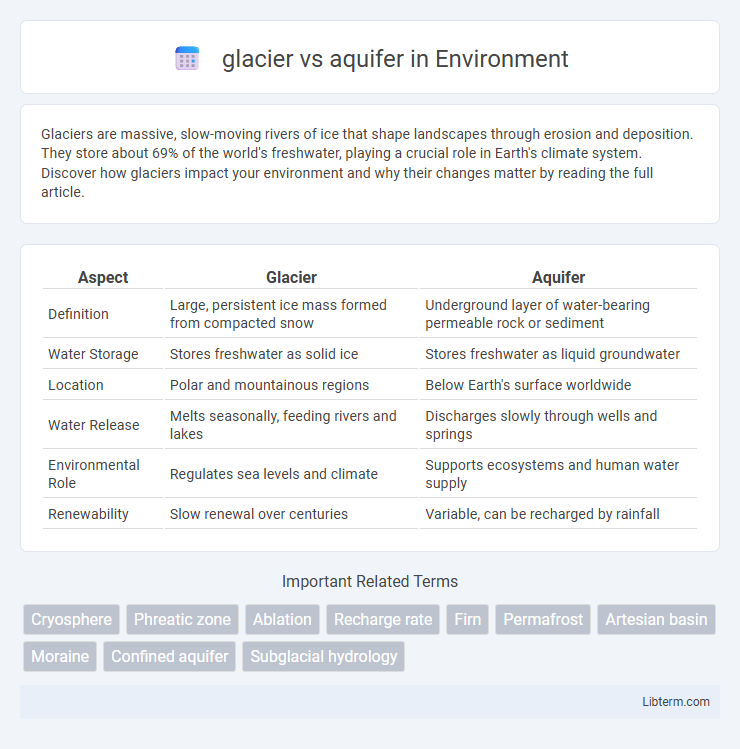Glaciers are massive, slow-moving rivers of ice that shape landscapes through erosion and deposition. They store about 69% of the world's freshwater, playing a crucial role in Earth's climate system. Discover how glaciers impact your environment and why their changes matter by reading the full article.
Table of Comparison
| Aspect | Glacier | Aquifer |
|---|---|---|
| Definition | Large, persistent ice mass formed from compacted snow | Underground layer of water-bearing permeable rock or sediment |
| Water Storage | Stores freshwater as solid ice | Stores freshwater as liquid groundwater |
| Location | Polar and mountainous regions | Below Earth's surface worldwide |
| Water Release | Melts seasonally, feeding rivers and lakes | Discharges slowly through wells and springs |
| Environmental Role | Regulates sea levels and climate | Supports ecosystems and human water supply |
| Renewability | Slow renewal over centuries | Variable, can be recharged by rainfall |
Introduction to Glaciers and Aquifers
Glaciers are massive, slow-moving ice bodies formed from compacted snow that store freshwater in frozen form, primarily found in polar regions and high mountains. Aquifers consist of permeable rock or sediment layers saturated with groundwater, serving as critical natural reservoirs for drinking water and irrigation. Both glaciers and aquifers play essential roles in Earth's hydrological cycle, but glaciers release water seasonally through melting, whereas aquifers provide more consistent subsurface water availability.
Defining Glaciers: Characteristics and Formation
Glaciers are large, persistent bodies of dense ice that form over centuries through the accumulation and compaction of snow in regions where snowfall exceeds melting. They exhibit distinct characteristics such as slow movement due to gravity, crevasses, and stratified layers reflecting seasonal snowfall. Unlike aquifers, which store groundwater in permeable rock or sediment, glaciers primarily act as freshwater reservoirs locked in solid ice.
Understanding Aquifers: Types and Structure
Aquifers are underground layers of water-bearing permeable rock, sediment, or soil that store and transmit groundwater, classified primarily into unconfined and confined types based on their geological structure. Unconfined aquifers have a permeable layer on top, allowing direct water infiltration from the surface, while confined aquifers are trapped between impermeable layers, resulting in pressurized water reserves. Unlike glaciers, which are surface ice masses formed from compacted snow, aquifers serve as critical subsurface water reservoirs essential for drinking water supplies and irrigation.
Geological Differences Between Glaciers and Aquifers
Glaciers are large masses of ice formed from compacted snow, primarily found in polar and mountainous regions, representing surface water storage in solid form. Aquifers consist of permeable rock or sediment layers, such as sandstone or limestone, that hold and transmit groundwater beneath the Earth's surface through pore spaces or fractures. The primary geological difference lies in glaciers being surface ice reservoirs shaped by climatic conditions, while aquifers function as subterranean water-bearing formations influenced by hydrogeological properties.
Water Storage Capacity: Glacier vs Aquifer
Glaciers store approximately 69% of the world's freshwater, primarily in solid ice form, while aquifers hold about 30% as groundwater within permeable rock and sediment layers. The water storage capacity of glaciers is limited by their geographic location and climate conditions, causing seasonal variations in water release. Aquifers offer more stable and accessible water reserves, making them critical for sustained freshwater supply in many regions.
Hydrological Role in the Water Cycle
Glaciers store about 69% of the world's fresh water, gradually releasing meltwater that sustains river flows and replenishes groundwater during warmer months, playing a crucial role in regulating seasonal water availability. Aquifers act as natural underground reservoirs, storing vast quantities of groundwater that support ecosystems, agriculture, and human consumption by slowly releasing water through wells and natural springs. Both glaciers and aquifers contribute significantly to the hydrological cycle by controlling water storage, flow, and distribution across different temporal and spatial scales.
Accessibility and Use of Water Resources
Glacier water is less accessible due to its location in remote, often mountainous regions, requiring specialized infrastructure for extraction and limited seasonal availability from melting. Aquifers provide more accessible groundwater resources that can be tapped via wells, offering consistent and reliable water supply for agriculture, drinking, and industrial use throughout the year. The sustainable management of aquifers is vital to prevent depletion and maintain long-term water availability compared to the more variable and climate-dependent glacier meltwater.
Impacts of Climate Change on Glaciers and Aquifers
Climate change accelerates glacier melting, causing significant runoff that disrupts freshwater availability and contributes to sea-level rise. Rising temperatures also reduce aquifer recharge rates by altering precipitation patterns and increasing evapotranspiration, leading to declining groundwater levels and compromised water supplies. The combined stress on glaciers and aquifers intensifies water scarcity, especially in regions dependent on glacial meltwater and groundwater resources.
Environmental Significance and Ecosystem Services
Glaciers act as critical freshwater reservoirs, slowly releasing meltwater that supports downstream ecosystems and maintains river flow during dry seasons, which is essential for biodiversity and agriculture. Aquifers store vast quantities of groundwater, providing a reliable source for drinking water, irrigation, and sustaining wetlands, thus supporting diverse ecosystems and human communities. Both glaciers and aquifers regulate hydrological cycles, mitigate drought impacts, and maintain habitat stability, highlighting their indispensable roles in environmental sustainability and ecosystem services.
Sustainable Management of Glacial and Aquifer Resources
Sustainable management of glacial and aquifer resources requires balancing extraction rates with natural recharge to prevent depletion and maintain ecosystem services. Glaciers act as critical freshwater reservoirs that feed rivers and aquifers, especially in mountainous regions vulnerable to climate change-induced melt variability. Implementing integrated water resource management and monitoring technologies enhances resilience by optimizing water use during dry seasons and reducing risks of water scarcity.
glacier Infographic

 libterm.com
libterm.com